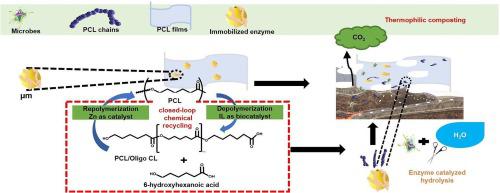当前位置:
X-MOL 学术
›
Chem. Eng. J.
›
论文详情
Our official English website, www.x-mol.net, welcomes your
feedback! (Note: you will need to create a separate account there.)
Faster biodegradable and chemically recyclable polycaprolactone with embedded enzymes: Revealing new insights into degradation kinetics
Chemical Engineering Journal ( IF 13.3 ) Pub Date : 2024-07-14 , DOI: 10.1016/j.cej.2024.153982 Naba Kumar Kalita , Doli Hazarika , Rajiv K. Srivastava , Minna Hakkarainen
Chemical Engineering Journal ( IF 13.3 ) Pub Date : 2024-07-14 , DOI: 10.1016/j.cej.2024.153982 Naba Kumar Kalita , Doli Hazarika , Rajiv K. Srivastava , Minna Hakkarainen

|
Embedding immobilized lipase (IL) enzymes into polycaprolactone (PCL) matrix was demonstrated as a promising route to faster biodegradable and chemically recyclable PCL products. Furthermore, the materials could be thermally processed by extrusion and 3D printed by fused filament fabrication technique. The embedded-enzymes were shown to effectively accelerate the degradation of PCL under simulated industrial composting conditions and in aqueous solution in combination with external enzymes. To reveal deeper insights into the underlying mechanisms, the biodegradation kinetic parameters governing organic carbon (OC) mineralization were calculated. Furthermore, the concept of biodegradation half-life (B1/2 ) was introduced and correlated with the organic carbon (OC) mineralization rate of enzyme-embedded PCL films and filaments, especially under thermophilic composting conditions. This sheds light on how the incorporation of immobilized enzymes into PCL facilitates the degradation process. Furthermore, the feasibility of enzyme-catalyzed chemical recycling under mild conditions followed by enzyme-catalyzed repolymerization was demonstrated. The applied material design principle holds promise for addressing the pressing challenges associated with plastic waste, when moving forward towards a more sustainable and environmentally conscious future.
中文翻译:

具有嵌入式酶的更快的生物降解和化学可回收聚己内酯:揭示降解动力学的新见解
将固定化脂肪酶 (IL) 嵌入聚己内酯 (PCL) 基质中被证明是一种有前途的途径,可更快地实现可生物降解和可化学回收的 PCL 产品。此外,这些材料可以通过挤压进行热处理,并通过熔丝制造技术进行 3D 打印。研究表明,在模拟工业堆肥条件下以及在水溶液中与外部酶结合时,嵌入酶可有效加速 PCL 的降解。为了更深入地了解潜在机制,计算了控制有机碳(OC)矿化的生物降解动力学参数。此外,引入了生物降解半衰期(B1/2)的概念,并将其与嵌入酶的 PCL 薄膜和丝的有机碳(OC)矿化率相关联,特别是在高温堆肥条件下。这揭示了将固定化酶掺入 PCL 如何促进降解过程。此外,还证明了在温和条件下酶催化化学回收和酶催化再聚合的可行性。在迈向更加可持续和环保的未来时,应用材料设计原则有望解决与塑料废物相关的紧迫挑战。
更新日期:2024-07-14
中文翻译:

具有嵌入式酶的更快的生物降解和化学可回收聚己内酯:揭示降解动力学的新见解
将固定化脂肪酶 (IL) 嵌入聚己内酯 (PCL) 基质中被证明是一种有前途的途径,可更快地实现可生物降解和可化学回收的 PCL 产品。此外,这些材料可以通过挤压进行热处理,并通过熔丝制造技术进行 3D 打印。研究表明,在模拟工业堆肥条件下以及在水溶液中与外部酶结合时,嵌入酶可有效加速 PCL 的降解。为了更深入地了解潜在机制,计算了控制有机碳(OC)矿化的生物降解动力学参数。此外,引入了生物降解半衰期(B1/2)的概念,并将其与嵌入酶的 PCL 薄膜和丝的有机碳(OC)矿化率相关联,特别是在高温堆肥条件下。这揭示了将固定化酶掺入 PCL 如何促进降解过程。此外,还证明了在温和条件下酶催化化学回收和酶催化再聚合的可行性。在迈向更加可持续和环保的未来时,应用材料设计原则有望解决与塑料废物相关的紧迫挑战。

















































 京公网安备 11010802027423号
京公网安备 11010802027423号